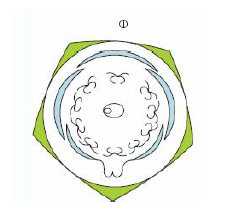Morphology Of Flowering Plants

Stem and its Functions
2. It helps in the conduction of water from the soil to different parts of the body.
3. It has conducting tissue that helps in the transportation of water to different parts of the plant.
4. It supports the plant and bears leaves, buds and fruits.
5. It has nodes and internodes
Stem modification
1. For food storage: Rhizome (ginger), Tuber (potato), Bulb (onion), Corm (Colocasia).
2. For support: Stem tendrils of watermelon, grapevine, cucumber.
3. For protection: Axillary buds of stem of citrus, Bougainvillea get modified into pointed thorns. They protect the plants from animals.
4. For vegetative propagation: Underground stems of grass, strawberry, lateral branches of mint and jasmine.
5. For assimilation of food: Flattened stem of Opuntia contains chlorophyll and performs photosynthesis.
The root system

Modifications of roots
2. Some of the roots like carrot and radish are modified to perform a special function like storage of food. The food stored in the roots is utilized during unfavorable conditions.
3. Roots like Rhizophora, are modified for gaseous exchange. They have minute pores which help to exchange gases.
4. Stilt roots provide mechanical support to the plant e.g., sugarcane.
5. Climbing roots provide aerial support to the plant e.g., vanilla.
6. Clinging roots provide mechanical support to the plants e.g., orchids.
7. Sucking roots help to withdraw nutrition from other parts of the plant e.g., Cuscuta.
8. Floating roots help the aquatic plants to store air e.g., water lily.
9. Assimilatory roots perform photosynthesis e.g., trapa.
Types of venation
1. Reticulate: Veinlets form a network as in leaves of dicotyledonous plants (china rose, peepal).
2. Parallel: Veins are parallel to each other as in leaves of monocotyledonous plants (grass, maize, sugarcane).
Modification of leaves
2. The xerophytic leaves are modified for storage of food.
3. Tendrils in sweet pea are modified to form support.
4. Leaves in the Optunia are modified into spines to curtail the level of transpiration.
5. In Bignonia, leaves are modified into hooks for climbing.
6. Leaves in Salvinia help to float.
7. The winged petiole in Acacia known as phyllode, acts like a leaf and performs the functions of leaves.
8. The leaves in insectivorous plants like pitcher plant, form pitcher-shaped structures. These aid in trapping the insects.
Structure of bisexual flower

1. A flower that contains both male and female reproductive organs is called a bisexual flower.
2. The male reproductive organ is called the androecium and the female reproductive organ is called the gynoecium.3. A bisexual flower consists of calyx, corolla, stamens, and carpel.
4. A unit of the calyx is called a sepal. Sepals are green in colour and are present just above the stalk of the flower.
5. A unit of the corolla is called a petal. Petals have different colours and are present above the sepals.
6. Androecium is the male reproductive part of the flower and is also called the stamen. Stamen is made up of an anther and a filament.
7. Gynoecium is the female reproductive part of the flower and is also called carpel. The parts of the carpel are style, stigma, and ovary.
Inflorescence
1. Inflorescence is the arrangement of flowers on the branch of the plant.
2. The main types of inflorescence are racemose and cymose inflorescence.
3. In racemose inflorescence, the terminal bud continues to grow further resulting in the orientation of the youngest flower at the apex and oldest at the base.
4. In cymose inflorescence, the terminal bud grows and dies resulting in the orientation of the oldest flower at the apex and the young flower at the base.
General structure of fruit
Fruits have three layers:
1. Exocarp, the outermost layer often consisting of only the epidermis
2. Mesocarp, or middle layer, which varies in thickness
3. Endocarp, which shows considerable variation from one species to another
Family : Fabaceae

2. Character: Majority of plants belonging to this family are pulses.
3. For example, pulses like Bengal gram, green gram, horse gram, etc.
Family: Solanaceae

2. Character: Persistent calyx
3. For example, Tomato, Chilli, Brinjal, etc., of potato family.
Family: Liliaceae

2. Character: Stem underground (bulb/corms/rhizomes).
3. For example, tulip, Gloriosa, aloe, Asparagus, etc.


